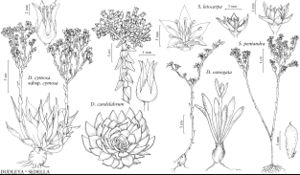Difference between revisions of "Sedella pentandra"
Madroño 3: 240, plate 12, figs. 4, 5. 1936,.
Synonyms: Parvisedum pentandrum (H. Sharsmith) R. T. Clausen
FNA>Volume Importer |
FNA>Volume Importer |
||
| Line 10: | Line 10: | ||
|name=Parvisedum pentandrum | |name=Parvisedum pentandrum | ||
|authority=(H. Sharsmith) R. T. Clausen | |authority=(H. Sharsmith) R. T. Clausen | ||
| + | |rank=species | ||
}} | }} | ||
|hierarchy=Crassulaceae;Sedella;Sedella pentandra | |hierarchy=Crassulaceae;Sedella;Sedella pentandra | ||
| Line 34: | Line 35: | ||
-->{{#Taxon: | -->{{#Taxon: | ||
name=Sedella pentandra | name=Sedella pentandra | ||
| − | |||
|authority=H. Sharsmith | |authority=H. Sharsmith | ||
|rank=species | |rank=species | ||
| Line 49: | Line 49: | ||
|publication year= | |publication year= | ||
|special status= | |special status= | ||
| − | |source xml=https://jpend@bitbucket.org/aafc-mbb/fna-data-curation.git/src/ | + | |source xml=https://jpend@bitbucket.org/aafc-mbb/fna-data-curation.git/src/f50eec43f223ca0e34566be0b046453a0960e173/coarse_grained_fna_xml/V8/V8_398.xml |
|genus=Sedella | |genus=Sedella | ||
|species=Sedella pentandra | |species=Sedella pentandra | ||
Revision as of 23:28, 16 December 2019
Plants 0.3–1.3 dm, often with 1–4 ascending branches shorter than main axis; hypocotyl 1–2 cm. Stems 5–15-noded. Leaf blades 0.4–0.7 × 0.2–0.3 cm. Cymes 1–5-branched, 2–12-flowered, sometimes flowers solitary, 1–4 cm. Flowers 2–3 mm diam.; calyx base thickened for 1 mm; petals ascending, later appressed to utricles, pale greenish yellow or with dorsal red streak, ovate-lanceolate, 1.5–2 × 0.5–0.6 mm, apex acute; stamens 5; pistils 1 mm, adaxially stipitate-glandular; styles erect, 0.2–0.4 mm. Utricles erect and appressed, 1.2–1.5 mm. Seeds 0.7–0.9 mm. 2n = 18.
Phenology: Flowering spring.
Habitat: Thin soil on slate, shale, sandstone, or serpentine
Elevation: 300-700 m
Discussion
M. W. Skinner and B. M. Pavlik (1994) considered Sedella pentandra for listing as rare in California but rejected it as too common.
Selected References
None.
Lower Taxa
None.

